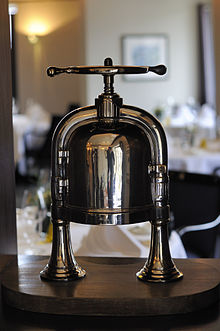Bleeding duck
In kitchen language, ducks that have been killed by suffocation so that their blood remains in the body are called bleeding ducks ( Canards au sang ) .
preparation

This slaughtering method has a tradition especially in Rouen for the large duck breed Rouen duck ( Canard rouennais ) with a slaughter weight of 2.5 to 3 kg. Due to the blood it contains, the meat is redder than in ducks slaughtered in other ways and is considered more tender.
Bleeding duck is served roasted immediately (no more than two hours) after slaughter so that the blood and protein in the meat juice do not coagulate - they form the basis of the sauce , for which the carcass is squeezed with a duck press after carving . The most famous dish is Rouen-style duck ( Canard à la rouennaise or Canard à la Rouen ), in which the sauce is made from blood and meat juice with cognac and, depending on the recipe, also red wine and raw, pureed duck liver.
Legal regulation in Germany
According to the German Animal Welfare Act , killing by suffocation is prohibited. For reasons of food law, slaughter without blood withdrawal is also prohibited in Germany. However, since both are permitted under European law, bleeding ducks may be imported into Germany from other European countries in accordance with the rules of the EU internal market.
See also
Individual evidence
- ↑ http://www.bund-deutscher-tierfreunde.de/bilder_neu/Flyer_Enten__2.pdf
- ^ According to information from the Federal Ministry of Food, Agriculture and Consumer Protection of April 26, 2011
Web links
- Illustrated preparation in the Tour d'Argent (Engl.)
- Video of a preparation (Engl.)